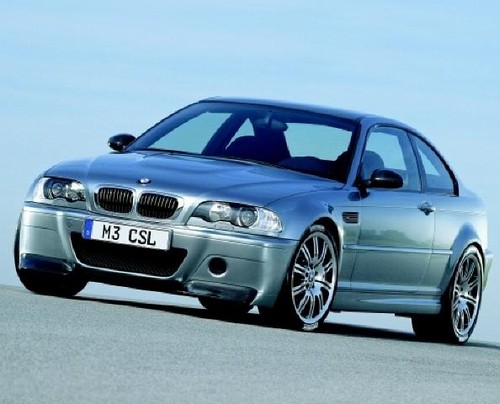Lightweight M3 from BMW M
BMW enthusiasts will remember ‘CSL’ as having been used for some BMW models in the 1970s. Now the initials make a return on a concept model – the M3 CSL – which was built by BMW’s M division. The concept is described as a lightweight sportscar which is intended to explore the potential of intelligent weight reduction.
Three facts describe the fortes of this prototype which was displayed at the Frankfurt Motorshow: weight reduction of about 200 kgs; power-to-weight ratio under 3.5 kgs/bhp;, lap time on the northern circuit of Nurburgring less than 8 minutes. The phenomenal lap time achieved is the result of a consistent concept based on “intelligent” lightweight engineering – the optimum combination of materials and components using the most suitable material for each component and its specific requirements. This strategy is directly connected to BMW’s Formula 1 technology carried over to the road by the M3 CSL on a number of fundamental points. Just one example is the consistent use on the car of carbon-fibre-reinforced plastic, the popular material in Formula 1 racing.
The high-speed concept of BMW M’s well-known M3 straight-six again underlines the role of lightweight engineering in engine construction. Thoroughly modified, the upgraded engine comes with a streamlined cylinder charge process and friction is reduced to a minimum, boosting output in the process with more than 257 kW/350 bhp.
And to shift gears within fractions of a second, ensuring a direct flow of power at all times, the car features BMW’s new Sequential M Gearbox with Drivelogic (SMG), again based directly on Formula 1 technology. Featuring electro-hydraulic, microprocessor-controlled clutch operation, this highly advanced transmission is operated by two paddles mounted on the steering wheel.
Lightweight engineering is nevertheless not a purpose in itself by the making of the M3 CSL. Rather, the absolute weight and the mass inertia of a car around its vertical axis are crucial to the car’s lateral, vertical and longitudinal dynamics – that is how the driver experiences the dynamic behaviour of his car. Just for comparison, the production BMW M3 weighs 1,495 kgs unladen, while the M3 CSL Concept Car is about 200 kilos lighter. This is the crucial factor, the power-to-weight ratio being essential for optimum longitudinal dynamics, and here the improvement is even more significant: the production M3 coming with a power-to-weight ratio of 4.36 kgs/bhp versus less than 3.5 kgs/bhp of the M3 CSL Concept Car – a 20% improvement.
There is no better place in the world to test all these dynamic performance criteria as thoroughly and quickly as the northern circuit of Nurburgring, the most demanding race track in the world. This is where the great stand out from the good and the good beat the bad in terms of their driving dynamics, with the total lap time obviously depending on the interplay of all components within the car. Covering the northern circuit in well under eight minutes, the M3 CSL Concept Car beats its production counterpart by almost 30 seconds.
The lightweight concept comes out clearly in the M3 CSL Concept Car in many respects and on many features. The flaps in the front airdam, exterior mirror housing and the roof are made of carbon-fibre. The front air dam itself as well as the doors are of carbon-fibre finished in body colour, as are the rear lid optimised for perfect streamlining with its higher rear spoiler and the rear-end diffuser. A solid sandwich panel takes the place of the through-loading bulkhead between the passenger compartment and the luggage compartment, and the two racing-style bucket seats for the driver and front passenger as well as the door linings, the centre console and instrument trim are also made of carbon-fibre-reinforced plastic.
Carbon-fibre is however not the only alternative. The body-in-white (an unpainted bare bodyshell) is pressed out of high-strength steel panels; the rear window is made of extra-thin glass; and the floorpan is in sandwich structure. The floor panel in the luggage compartment, in turn, is a honeycomb sandwich plate normally to be found only in aerospace applications, while the substrate beneath the instrument panel is made of magnesium. Even the bottom layer beneath the carpet on the floor comes in weight-optimised foam. The M3 CSL Concept Car rests on alloy 19-inch wheels incorporating 18-inch lightweight brakes for maximum stopping power.
In the minds of the designers, the pursuit of weight savings does not mean that comfort has to be sacrificed or that the occupants must travel in spartan surroundings. All the usual amenities found in a standard BMW M3 are still present with the exception of side airbags, the toolbox and the rear seats being replaced by storage boxes. Of course, if maximum weight reduction is the aim, then a lot of stuff would be omitted as in racing saloons which don’t even have carpets or door panels.
BMW advises you not to wait for the M3 CSL because it is only a design study and there are no plans to produce such a model for sale.



























